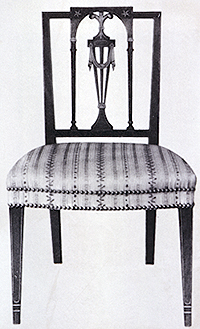
The first Harrison Gray Otis House, 1795, Boston. The architect was Charles Bulfinch.

The first Harrison Gray Otis House, 1795, Boston. The architect was Charles Bulfinch.

The first Harrison Gray Otis House, by Charles Bulfinch. The Parlor.

The first Harrison Gray Otis House, by Charles Bulfinch. The withdrawing room.

Villa Boscobel. Entrance facade. Built early in the 19th century in Montrose, New York for Morris Dychman (1755-1806), and moved to Garrison-on-Hudson, New York in the 1950s. Architect unknown but may have been Robert Mills.

Villa Boscobel, front drawing room.

Side chair by Samuel McIntire, Salem, Massachusetts, mahogany, circa 1795. Design derived from plate 2 of Hepplewhite's Cabinet Maker and Upholsterer's Guide published in 1788.

American Sheraton-style chair, circa 1800, mahogany, attributed to John Seymour of Boston.

Armchair of mahogany with birch inlay made in New Hampshire circa 1800-1810. This type of chair with its tall, slender or attenuated proportions was characteristic of New England and is often called a "Martha Washington Chair."

Mahogany sofa attributed to Samuel McIntire, Salem, Mass. circa 1795.

Lady's Desk, mahogany, by John Seymour of Boston, circa 1796-1805.

Room with furniture by Duncan Phyfe, New York, circa 1800.

Mahogany side chair by Duncan Phyfe, circa 1800-1810.

Side chair of a type particularly popular in New York, 1790-1800. The design is taken from plate 36 of Sheraton's Drawing Book 1791-1794.

Oval-back side chair, Philadelphia, 1796. Painted beech.

Lady's desk of mahogany with satinwood inlay and reverse painted glass decoration, circa 1795-1805.
The copyright law of the United States (Title 17, United States Code) governs the making of photocopies or other reproductions of copyrighted material. The University of Oregon adheres to this statute by relying on the fair use provisions of the copyright law and by obtaining permission of the copyright holder where applicable. One of the conditions of the copyright law as it applies to libraries specifies that a photocopy or reproduction is not to be used for "any purpose other than private study, scholarship, or research. A user may be liable for copyright infringement if a user makes a request for, or later uses, a photocopy or reproduction for purposes in excess of "fair use," or for purposes prohibited by the stated terms and conditions set by a publisher or vendor.